NOTE: For those of you who don't already know, the international jousting tournament at Arundel Castle is one of the most prestigious, historically accurate and physically challenging jousting tournaments in the world today. The organizers of the “Arundel International Tournament” were kind enough to write the following article which explains a little about the history of Arundel Castle and the historic family who still calls it home, as well as giving a nice summary of this year's tournament.
Written by “Arundel International Tournament”:
A leading figure during the Wars of the Roses was John Howard, one of the fiercest and most loyal supporters of the House of York. He was knighted by Edward IV at the Battle of Towton in 1461, became a member of the King’s Council in 1467, and went into exile when Edward lost the throne in 1470. He was a noted jouster, and presided as Marshal over “the most splendid tournament of the age” in which the Bastard of Burgundy jousted against Lord Scales. He carried the Royal Standard at Edward IV’s funeral in 1483, and in the same year was created 1st Duke of Norfolk and Earl-Marshal of England by Richard III. He found his end at the Battle of Bosworth in 1485, fighting loyally for the last Plantagenet King of England.
Despite their misfortunes at Bosworth, the Howard family managed to hold on to or reclaim the titles won by John Howard, so that the current (18th) Duke of Norfolk is his direct descendant: His Grace Edward Fitzalan-Howard, Duke of Norfolk, Earl of Arundel and Surrey, premier peer of England, residing at magnificent Arundel Castle in West Sussex. Built in 1067 after the Norman Conquest to fortify the mouth of the River Arun, Arundel is England’s second-largest castle, and certainly one of the country’s most beautiful historic sites.
The castle includes the original Norman motte-and-bailey, a large part of its 14th century curtain wall and gate houses, one of the largest libraries in England, the modern reconstruction of a formal garden based on original 17th century plans by Inigo Jones, and an extensive collection of effigies and artifacts. And once a year it hosts within its walls the UK’s largest jousting tournament – which is only befitting the venue, given that the current Duke of Norfolk still holds the title of Earl-Marshal of England, bestowed upon his forefather by Richard III.
This year, four teams representing the major powers of medieval Europe competed against each other: The Holy Roman Empire took the team championship last year and was determined to defend the title.
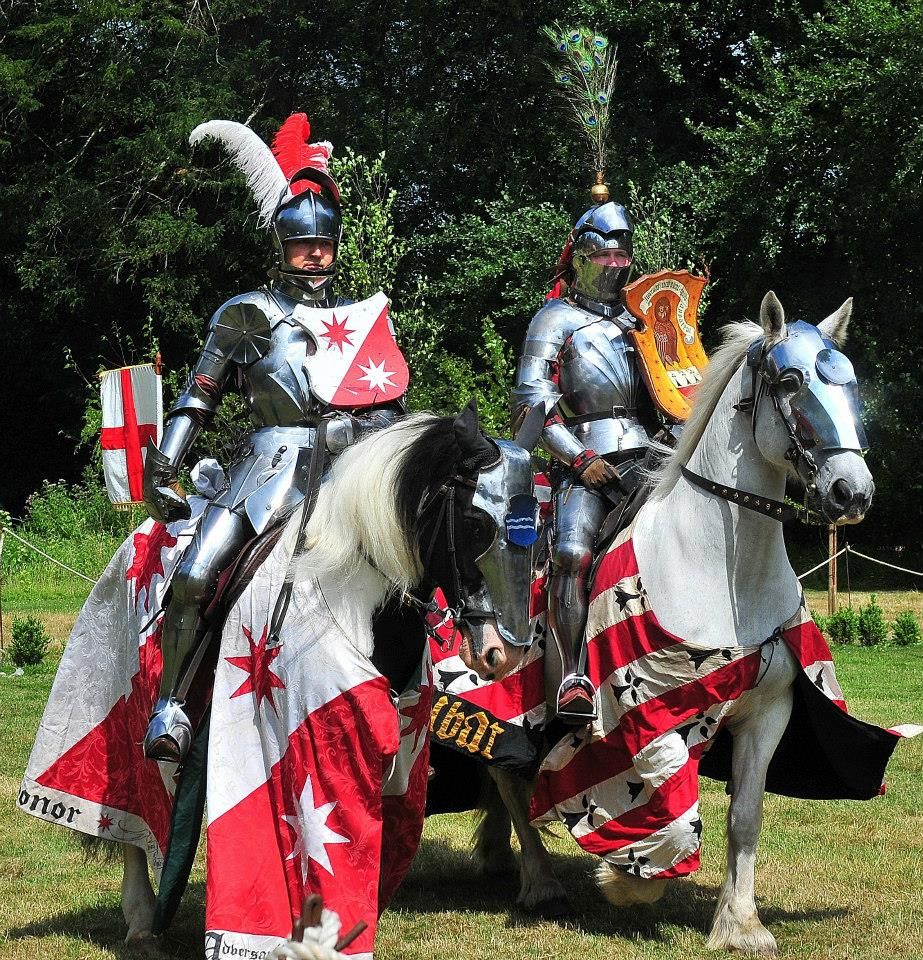
The Holy Roman Empire: Andreas Wenzel of Germany(left) and Jan Gradon of Poland(right)
(Photo by Richard Pearn)
The Kingdom of England was still reeling from last year’s team defeat and was desperate to win back the championship.
The Kingdom of France missed the final last year and was resolved on doing better this time.


The Kingdom of France: Marcus Hamel(left) and Steve R. Gagnon(right) of Quebec, Canada
(photos by Richard Pearn)
And the Duchy of Burgundy made its first appearance at Arundel, an unknown quantity keen on giving good account of itself.

The Duchy of Burgundy: Wouter Nicolai(left) and Ben van Koert(right) of the Netherlands
(photo by Richard Pearn)
The "Arundel International Tournament" is held over six days of continuous jousting in a variety of two and four man heats, making it to our knowledge the most extensive jousting competition held today. The long duration challenges the competitors considerably, in terms of physical fitness, horsemanship, and general consistency. Each jouster has to ride a variety of horses, compete in changing weather, deal with fatigue and injury over a long time period, and keep his mind calm despite building pressure. The latter can be a particular challenge. Every morning each jouster walks past the scoreboard, mercilessly reminding him, even before breakfast, of his current position in the ranking. Every evening each jouster walks past the scoreboard on his way to bed, reminding him of his defeats or victories of the day.
This mental pressure is compounded by the historically inspired scoring system used for the tournament. While each jousting round is scored as per the UK standard (1 point for arm, 2 points for chest, 3 points for shield or head, 1 additional point for breaking the lance far down, 1 additional point for horsemanship), these “strike scores” are not taken into account for the placements.
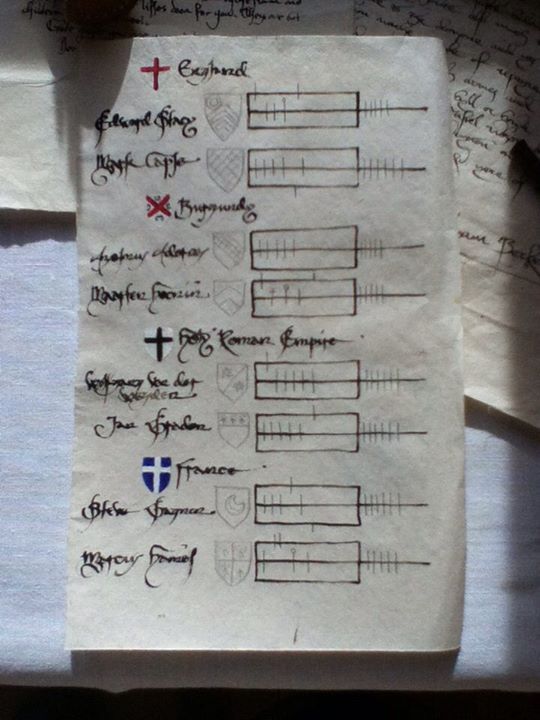
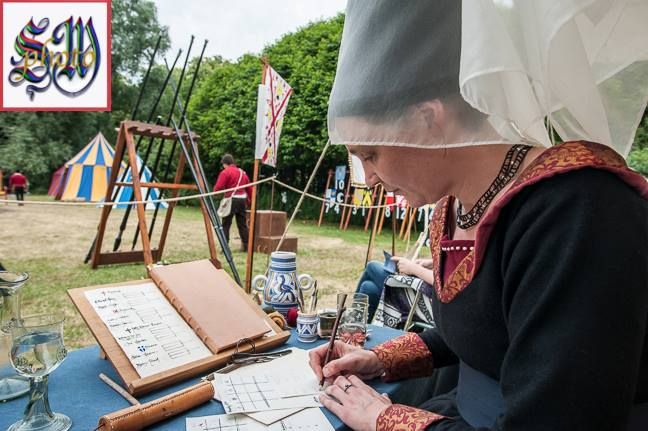
Left: Scoring Sheet(photo by Catherine Tranter)
Right: Catherine Tranter carefully scribes the scores for each match(photo by Stephen Moss)
Instead the tournament rules attempt to align themselves with 15th century sources, putting a particular emphasis on who achieved victory in each round: The highest scorer in each jousting match receives three points, the second-placed individual two, the third-placed one. The last-placed jouster receives no scores for the board. This scoring system is particularly harsh in the two-man heats, where the winning team receives three points, but the losing team none at all.
The team which shone throughout the tournament right up to the final, appearing virtually untouchable, were the defending champions: the Holy Roman Empire. Except for their second match, in which they placed second, the Imperial Jousting Team won every one of their ten confrontations and ended up with an unprecedented team score of 29 out of a maximum 30. Alas, this impressive feat meant nothing more than a place in the final, for which the score board would be wiped to zero. For the Sunday final, the Empire was joined by England, whose team had comfortably stayed ahead of rival team France with a score of 16.
What ensued then was arguably one of the most nail-biting jousting finals many recall. The Empire surged ahead straight away with the same consistency they had displayed all week, leaving England behind after an early miss by Evans. Through the next rounds the Imperial team expanded their lead by virtue of hitting harder, thus gaining breakage points over England. This found its culmination in a miss by Caple, which put the Empire seven points in the lead with only two courses to go. Given that at this point England needed two shield hits with breakage and for the highly consistent Empire to miss both times in order to win, the English Jousting Team might be forgiven for losing heart.
However, the seemingly impossible happened. On his last course of the tournament, Wenzel's coronel slipped off Caple's targe with the lance remaining whole(scoring no points), while Caple struck the shield and broke to the socket(scoring four points).
When Evans and Gradon then walked their horses up to position and lowered their visors for the last course of the week-long tournament, the entire arena with its 3000 onlookers fell silent, and remained so throughout the course – only to burst into deafening cheers when the scoring marshals indicated their verdict: Strike to the shield to Evans, and… a barricade to Gradon.
After the Knight-Marshal had awarded Evans the all-important breakage point, and the ladies had confirmed that they abstained from awarding horsemanship points to any of the jousters, the results were clear. In a confrontation one might liken to the combat of David and Goliath, England had managed a most remarkable reversal of fortune and snatched the team title from the Empire with a score of 33 to 32. Against all odds, England won the Team Championship of “Arundel International Tournament 2013”.

Team Champions: Stacy Evans(left) and Mark Caple(right) of the Kingdom of England
(photo by Stephen Moss)

The rings given to the team champions were created by Nicky Wade of Gemmeus
(photo from Arundel International Tournament Facebook page)
Having remained undefeated throughout the tournament with a score of 15 out of a possible 15, Andreas Wenzel (Holy Roman Empire) won the Individual Championship of “Arundel International Tournament 2013”, receiving the gilt chain of the Order of Arundel and joining last year’s champion Dominic Sewell as the second Knight of the Order.

Individual Champion Andreas Wenzel(photo from Arundel Castle Facebook page)
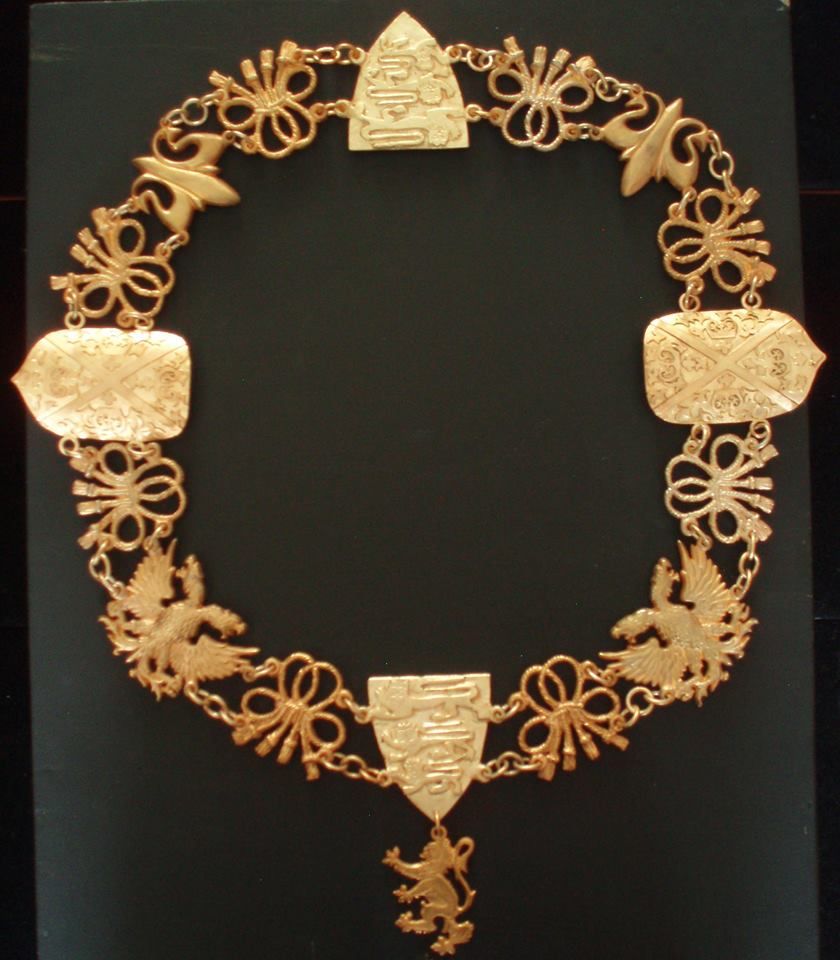
Chain with images representing the four teams competing in 2013 created by Nicky Wade of Gemmaus (photo from Arundel International Tournament Facebook page)
Traditionally, the Individual Champion is offered the honour of acting as Knight-Marshal at next year’s tournament. Andreas accepted and was therefore presented with the marshal’s baton by Dominic Sewell who most ably wielded it as this year’s Knight-Marshal. Hence Andreas Wenzel will be the Knight-Marshal of the "Arundel International Tournament 2014".
During the week the jousters also competed in a Hunting Skills(Mounted Skill at Arms) competition, which involved a variety of mounted disciplines using lances, swords, javelins and archery.
The Hunting Skills Trophy, a horn with gilt fittings, was awarded to Mark Caple (England), who achieved a clear lead over all other competitors displaying exquisite skill and horsemanship.

Hunting Horn and Garter of Chivalry created by Bayley Heritage Castings

Stacy Evans congratulates Mark Caple on winning the Hunting Horn(photo by Stephen Moss)
A large part of the tournament proceedings, including the award of horsemanship points, was presided over by a group of ladies, namely Kyle van Dolah (Leading Lady), Kate Vigurs (Event Presenter) and Catherine Tranter (Scoring Scribe). These ladies ran a systematic (but secret) score on each competitor’s performance against a range of chivalric virtues, with the objective to award a Chivalry Prize at the end of the tournament.
During the week a whole range of chivalric deeds were performed – for example Stacy Evans losing a jewel from his crest to Andreas Wenzel’s lance, and presenting Andreas with that same jewel afterwards as a gift. Wouter Nicolai, Max Knegjens and Andreas Wenzel entertaining the camp with their lute-play, and Jan Gradon giving a stunning performance when singing an ancient heroic song from his home country in Ben van Koert's honour.
Or Ben van Koert bringing a chest of gold(chocolate) coins with him and advising his valets to throw a handful into the crowd every time one of his opponents broke a lance upon him. Ben then announced to the assembled jousters that he would present a jewel to the first man breaking a lance against him after all gold coins had been spent – a prize subsequently won by Marc Hamel on Saturday. And it was in fact Ben van Koert who the ladies deemed most worthy of the Arundel Castle Chivalry Prize, gaining the honour of wearing the award – a garter with gilt fittings and letters – around his greave.
The “Arundel International Tournament” is the largest tournament in the UK. It arguably is also the most challenging (on account of its duration) and the most flamboyant. Very similar to the tournaments of old, Arundel is characterized by competitors trying to outdo each other, through having the most extravagant crests, making the most impressive entry to the lists, wearing the most beautiful armour and clothing and displaying the most chivalric spirit.
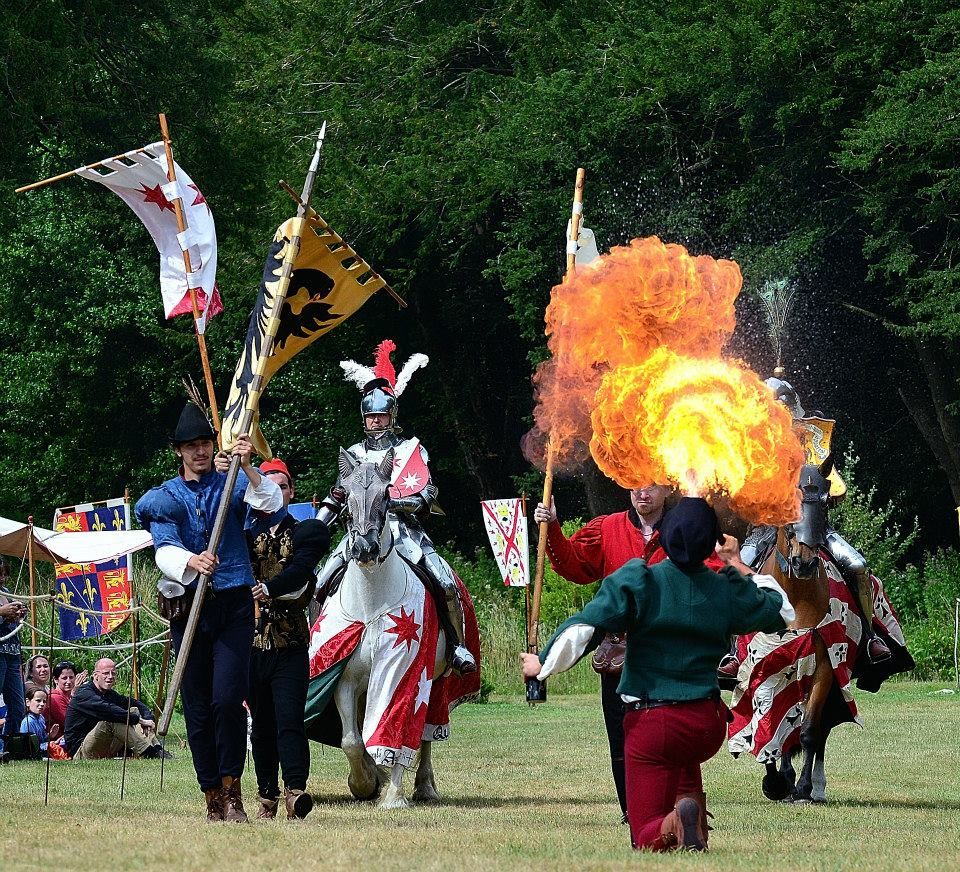
Andreas Wenzel and Jan Gradon enter the lists preceded by the Imperial Fire Breather
(photo by Richard Pearn)
However, probably the most memorable moment of the “Arundel International Tournament 2013” occurred after the tension of the final had subsided, and after awards had been received by deserving competitors. Once all was said and done, Stacy Evans dismounted, grabbed a microphone, and began addressing the public. After introducing himself as the Tournament Director, he began speaking of his love for his partner, Leading Lady Kyle van Dolah. When he then produced a little black box and descended onto one knee, the baffled public erupted into cheers.
Stacy's broken-voiced marriage proposal and the subsequent tearful “Yes” by his now-fiancee Kyle provided an amazingly beautiful end to a unique tournament.
Written by “Arundel International Tournament”:
A leading figure during the Wars of the Roses was John Howard, one of the fiercest and most loyal supporters of the House of York. He was knighted by Edward IV at the Battle of Towton in 1461, became a member of the King’s Council in 1467, and went into exile when Edward lost the throne in 1470. He was a noted jouster, and presided as Marshal over “the most splendid tournament of the age” in which the Bastard of Burgundy jousted against Lord Scales. He carried the Royal Standard at Edward IV’s funeral in 1483, and in the same year was created 1st Duke of Norfolk and Earl-Marshal of England by Richard III. He found his end at the Battle of Bosworth in 1485, fighting loyally for the last Plantagenet King of England.
Despite their misfortunes at Bosworth, the Howard family managed to hold on to or reclaim the titles won by John Howard, so that the current (18th) Duke of Norfolk is his direct descendant: His Grace Edward Fitzalan-Howard, Duke of Norfolk, Earl of Arundel and Surrey, premier peer of England, residing at magnificent Arundel Castle in West Sussex. Built in 1067 after the Norman Conquest to fortify the mouth of the River Arun, Arundel is England’s second-largest castle, and certainly one of the country’s most beautiful historic sites.
The castle includes the original Norman motte-and-bailey, a large part of its 14th century curtain wall and gate houses, one of the largest libraries in England, the modern reconstruction of a formal garden based on original 17th century plans by Inigo Jones, and an extensive collection of effigies and artifacts. And once a year it hosts within its walls the UK’s largest jousting tournament – which is only befitting the venue, given that the current Duke of Norfolk still holds the title of Earl-Marshal of England, bestowed upon his forefather by Richard III.
This year, four teams representing the major powers of medieval Europe competed against each other: The Holy Roman Empire took the team championship last year and was determined to defend the title.

The Holy Roman Empire: Andreas Wenzel of Germany(left) and Jan Gradon of Poland(right)
(Photo by Richard Pearn)
The Kingdom of England was still reeling from last year’s team defeat and was desperate to win back the championship.
The Kingdom of France missed the final last year and was resolved on doing better this time.


The Kingdom of France: Marcus Hamel(left) and Steve R. Gagnon(right) of Quebec, Canada
(photos by Richard Pearn)
And the Duchy of Burgundy made its first appearance at Arundel, an unknown quantity keen on giving good account of itself.

The Duchy of Burgundy: Wouter Nicolai(left) and Ben van Koert(right) of the Netherlands
(photo by Richard Pearn)
The "Arundel International Tournament" is held over six days of continuous jousting in a variety of two and four man heats, making it to our knowledge the most extensive jousting competition held today. The long duration challenges the competitors considerably, in terms of physical fitness, horsemanship, and general consistency. Each jouster has to ride a variety of horses, compete in changing weather, deal with fatigue and injury over a long time period, and keep his mind calm despite building pressure. The latter can be a particular challenge. Every morning each jouster walks past the scoreboard, mercilessly reminding him, even before breakfast, of his current position in the ranking. Every evening each jouster walks past the scoreboard on his way to bed, reminding him of his defeats or victories of the day.
This mental pressure is compounded by the historically inspired scoring system used for the tournament. While each jousting round is scored as per the UK standard (1 point for arm, 2 points for chest, 3 points for shield or head, 1 additional point for breaking the lance far down, 1 additional point for horsemanship), these “strike scores” are not taken into account for the placements.


Left: Scoring Sheet(photo by Catherine Tranter)
Right: Catherine Tranter carefully scribes the scores for each match(photo by Stephen Moss)
Instead the tournament rules attempt to align themselves with 15th century sources, putting a particular emphasis on who achieved victory in each round: The highest scorer in each jousting match receives three points, the second-placed individual two, the third-placed one. The last-placed jouster receives no scores for the board. This scoring system is particularly harsh in the two-man heats, where the winning team receives three points, but the losing team none at all.
The team which shone throughout the tournament right up to the final, appearing virtually untouchable, were the defending champions: the Holy Roman Empire. Except for their second match, in which they placed second, the Imperial Jousting Team won every one of their ten confrontations and ended up with an unprecedented team score of 29 out of a maximum 30. Alas, this impressive feat meant nothing more than a place in the final, for which the score board would be wiped to zero. For the Sunday final, the Empire was joined by England, whose team had comfortably stayed ahead of rival team France with a score of 16.
What ensued then was arguably one of the most nail-biting jousting finals many recall. The Empire surged ahead straight away with the same consistency they had displayed all week, leaving England behind after an early miss by Evans. Through the next rounds the Imperial team expanded their lead by virtue of hitting harder, thus gaining breakage points over England. This found its culmination in a miss by Caple, which put the Empire seven points in the lead with only two courses to go. Given that at this point England needed two shield hits with breakage and for the highly consistent Empire to miss both times in order to win, the English Jousting Team might be forgiven for losing heart.
However, the seemingly impossible happened. On his last course of the tournament, Wenzel's coronel slipped off Caple's targe with the lance remaining whole(scoring no points), while Caple struck the shield and broke to the socket(scoring four points).
When Evans and Gradon then walked their horses up to position and lowered their visors for the last course of the week-long tournament, the entire arena with its 3000 onlookers fell silent, and remained so throughout the course – only to burst into deafening cheers when the scoring marshals indicated their verdict: Strike to the shield to Evans, and… a barricade to Gradon.
After the Knight-Marshal had awarded Evans the all-important breakage point, and the ladies had confirmed that they abstained from awarding horsemanship points to any of the jousters, the results were clear. In a confrontation one might liken to the combat of David and Goliath, England had managed a most remarkable reversal of fortune and snatched the team title from the Empire with a score of 33 to 32. Against all odds, England won the Team Championship of “Arundel International Tournament 2013”.

Team Champions: Stacy Evans(left) and Mark Caple(right) of the Kingdom of England
(photo by Stephen Moss)

The rings given to the team champions were created by Nicky Wade of Gemmeus
(photo from Arundel International Tournament Facebook page)
Having remained undefeated throughout the tournament with a score of 15 out of a possible 15, Andreas Wenzel (Holy Roman Empire) won the Individual Championship of “Arundel International Tournament 2013”, receiving the gilt chain of the Order of Arundel and joining last year’s champion Dominic Sewell as the second Knight of the Order.

Individual Champion Andreas Wenzel(photo from Arundel Castle Facebook page)

Chain with images representing the four teams competing in 2013 created by Nicky Wade of Gemmaus (photo from Arundel International Tournament Facebook page)
Traditionally, the Individual Champion is offered the honour of acting as Knight-Marshal at next year’s tournament. Andreas accepted and was therefore presented with the marshal’s baton by Dominic Sewell who most ably wielded it as this year’s Knight-Marshal. Hence Andreas Wenzel will be the Knight-Marshal of the "Arundel International Tournament 2014".
During the week the jousters also competed in a Hunting Skills(Mounted Skill at Arms) competition, which involved a variety of mounted disciplines using lances, swords, javelins and archery.
Mark Atkinson(top right), Kyle van Dolah(center) and Mark Caple(bottom left) during the Hunting Skills(Mounted Skill at Arms) competition(photos by Richard Pearn)
The Hunting Skills Trophy, a horn with gilt fittings, was awarded to Mark Caple (England), who achieved a clear lead over all other competitors displaying exquisite skill and horsemanship.

Hunting Horn and Garter of Chivalry created by Bayley Heritage Castings

Stacy Evans congratulates Mark Caple on winning the Hunting Horn(photo by Stephen Moss)
A large part of the tournament proceedings, including the award of horsemanship points, was presided over by a group of ladies, namely Kyle van Dolah (Leading Lady), Kate Vigurs (Event Presenter) and Catherine Tranter (Scoring Scribe). These ladies ran a systematic (but secret) score on each competitor’s performance against a range of chivalric virtues, with the objective to award a Chivalry Prize at the end of the tournament.
During the week a whole range of chivalric deeds were performed – for example Stacy Evans losing a jewel from his crest to Andreas Wenzel’s lance, and presenting Andreas with that same jewel afterwards as a gift. Wouter Nicolai, Max Knegjens and Andreas Wenzel entertaining the camp with their lute-play, and Jan Gradon giving a stunning performance when singing an ancient heroic song from his home country in Ben van Koert's honour.
Or Ben van Koert bringing a chest of gold(chocolate) coins with him and advising his valets to throw a handful into the crowd every time one of his opponents broke a lance upon him. Ben then announced to the assembled jousters that he would present a jewel to the first man breaking a lance against him after all gold coins had been spent – a prize subsequently won by Marc Hamel on Saturday. And it was in fact Ben van Koert who the ladies deemed most worthy of the Arundel Castle Chivalry Prize, gaining the honour of wearing the award – a garter with gilt fittings and letters – around his greave.
Ben Van Koert receives the Garter of Chivalry from Catherine Tranter(photos by Stephen Moss)
The “Arundel International Tournament” is the largest tournament in the UK. It arguably is also the most challenging (on account of its duration) and the most flamboyant. Very similar to the tournaments of old, Arundel is characterized by competitors trying to outdo each other, through having the most extravagant crests, making the most impressive entry to the lists, wearing the most beautiful armour and clothing and displaying the most chivalric spirit.

Andreas Wenzel and Jan Gradon enter the lists preceded by the Imperial Fire Breather
(photo by Richard Pearn)
However, probably the most memorable moment of the “Arundel International Tournament 2013” occurred after the tension of the final had subsided, and after awards had been received by deserving competitors. Once all was said and done, Stacy Evans dismounted, grabbed a microphone, and began addressing the public. After introducing himself as the Tournament Director, he began speaking of his love for his partner, Leading Lady Kyle van Dolah. When he then produced a little black box and descended onto one knee, the baffled public erupted into cheers.
Stacy Evans proposes to Kyle van Dolah(photos by Stephen Moss)
Stacy's broken-voiced marriage proposal and the subsequent tearful “Yes” by his now-fiancee Kyle provided an amazingly beautiful end to a unique tournament.









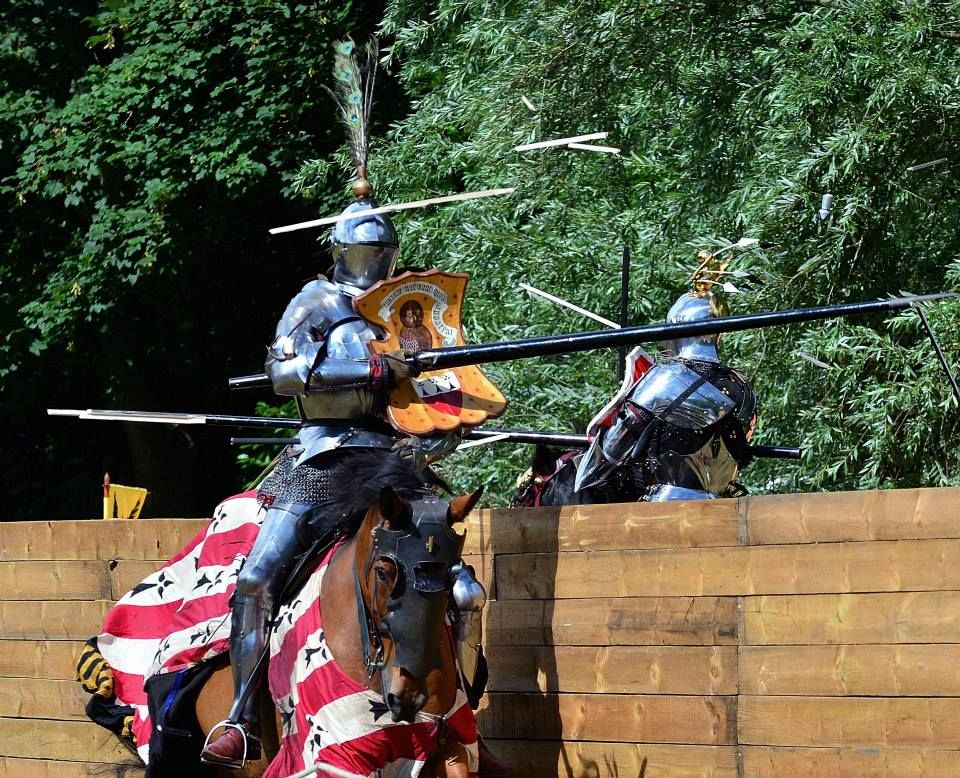












No comments:
Post a Comment